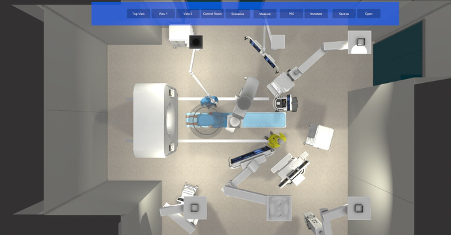Many of our customers use Visionary Render to plan manufacturing facilities. The ability to import whole assemble lines, modify and view in Virtual Reality (VR) have helped companies plan new or upgraded facilities. For example, see this case study from Siemens Congleton.
Typically, these environments are “traditional” manufacturing lines with large scale industrial machinery, robotics and component parts interacting together on the assembly line.
The line assembly crew might be Surgeons and Anesthesiologists, the part being worked on might be a person, the robotic equipment might be a MRI scanner but how do you use the same VR technology to help layout out and review a highly complex, medical operating theatre?
Many of the same challenges exist –
Our customer (a leading medical equipment supplier) had a problem of communicating design intent and layout of surgical rooms to their end customer. These surgical rooms are highly complex with many configurations of equipment to support different medical procedures, different combinations of medical teams and personal preference on placement.
The existing process was to use an image of a 2D architectural plan of the proposed room overlaid with symbols for each of the pieces of equipment. These plans and symbols were manipulated – in Powerpoint – to show the room layout for each of several scenarios.
The customer was then expected to sign this off and place a multi-million-dollar order.
This often led to misunderstandings, lack of clarity and expensive rework and adjustments.
Based on our experience with delivering layout planning solutions relying on out of the box capabilities of Visionary Render such as such as clash detection, animation, 3D measurement, we knew Visionary Render would be a great tool to support both the initial planning and the final customer presentation.

The developed solution based on Visionary Render incorporated animated and controllable highly complex medical equipment with their exact range of movements and control points. This allowed the clinical design team to check operating procedures in any combination.
Another key feature the clinical design team used was the ability to quickly set up a new room layout and save it as a pre-set. A prebuilt library of components was built which could be dragged and dropped into the 3D shell of the room. This allowed the sales team to quickly iterate between proposed solutions and layouts.

Additionally, the sales teams were able to further increase the impact of their discussions with hospital teams by:
A number of benefits were identified during the project:

The developed solution could be made available on Virtalis Reach so the surgical room layout can be made available to a wider range of Doctors, Surgeons, Hospital Administrators and decision makers via the web and using the latest visualisation technology.
The visualisation tools provided by Virtalis helped planning, design and communication of highly complex surgical room layouts reducing the sales cycle and project risks.